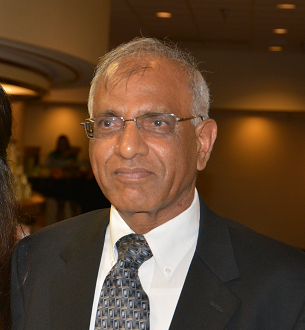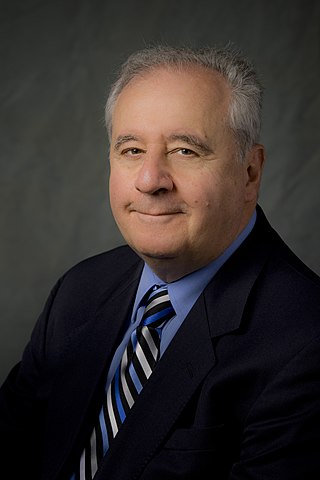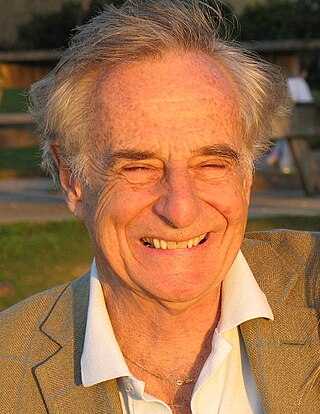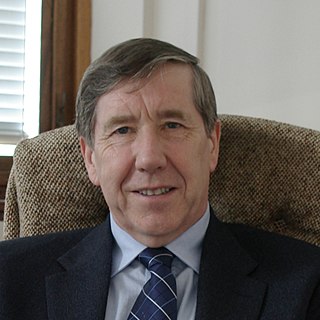Bhushan Lal Karihaloo, FIEAus MASME FASCE FLSW, is a professor of civil, architectural, and environmental engineering. He is head of the Institute of Theoretical, Applied and Computational Mechanics at Cardiff University and an expert on fracture mechanics. In 2006 he was awarded the European Structural Integrity Society's Griffith Medal for "his outstanding research in the field of theoretical fracture mechanics and fracture of quasi-brittle materials, in particular of concrete, fibre-reinforced cementitious composites, and advanced tough ceramics". In 2012, he was elected a Fellow of the Learned Society of Wales.
Applied mechanics is the branch of science concerned with the motion of any substance that can be experienced or perceived by humans without the help of instruments. In short, when mechanics concepts surpass being theoretical and are applied and executed, general mechanics becomes applied mechanics. It is this stark difference that makes applied mechanics an essential understanding for practical everyday life. It has numerous applications in a wide variety of fields and disciplines, including but not limited to structural engineering, astronomy, oceanography, meteorology, hydraulics, mechanical engineering, aerospace engineering, nanotechnology, structural design, earthquake engineering, fluid dynamics, planetary sciences, and other life sciences. Connecting research between numerous disciplines, applied mechanics plays an important role in both science and engineering.
Dr. Ramulu Mamidala is a mechanical engineering professor at University of Washington. Usually goes by the name 'Ram', or 'M.R.', he is recognized for his leadership and outstanding record in promoting collaborative education and research with industry. He is currently the director of Manufacturing Science and Technology Laboratory (MSTL) at Mechanical Engineering Department, University of Washington. He has designed and developed manufacturing methods for a wide range of systems, from the B2 bomber to the Boeing 787. Additionally, in collaboration with industry, he established and directed two interdisciplinary graduate educational programs in engineering and management and a certificate program in composites tooling and manufacturing. His exemplary collaborative efforts motivated working engineers to pursue doctoral studies and he is a leader in using emerging technologies in distance education to reach non-traditional students.

Zdeněk Pavel Bažant is McCormick School Professor and Walter P. Murphy Professor of Civil Engineering and Materials Science in the Department of Civil and Environmental Engineering at Northwestern University's Robert R. McCormick School of Engineering and Applied Science.
Satya Atluri was an Indian American engineer, educator, researcher and scientist in aerospace engineering, mechanical engineering and computational sciences, who was a Distinguished Professor Emeritus of Aerospace Engineering at the University of California, Irvine. Since 1966, he made fundamental contributions to the development of finite element methods, boundary element methods, Messless Local Petrov-Galerkin (MLPG) methods, Fragile Points Methods, Local Variational Iteration Methods, for general problems of engineering, solid mechanics, fluid dynamics, heat transfer, flexoelectricity, ferromagnetics, gradient and nonlocal theories, nonlinear dynamics, shell theories, micromechanics of materials, structural integrity and damage tolerance, Orbital mechanics, Astrodynamics, digital Twins of Aerospace Systems, etc.

Junuthula N. Reddy is a Distinguished Professor, Regent's Professor, and inaugural holder of the Oscar S. Wyatt Endowed Chair in Mechanical Engineering at Texas A&M University, College Station, Texas, USA.[1] He is an authoritative figure in the broad area of mechanics and one of the researchers responsible for the development of the Finite Element Method (FEM). He has made significant seminal contributions in the areas of finite element method, plate theory, solid mechanics, variational methods, mechanics of composites, functionally graded materials, fracture mechanics, plasticity, biomechanics, classical and non-Newtonian fluid mechanics, and applied functional analysis. Reddy has over 620 journal papers and 20 books and has given numerous national and international talks. He served as a member of the International Advisory Committee at ICTACEM, in 2001 and keynote addressing in 2014.[2][3]

Dan Mircea Frangopol is an American civil engineer and the inaugural holder of the Fazlur R. Khan Endowed Chair of Structural Engineering and Architecture at Lehigh University, Bethlehem, Pennsylvania.
Alberto Carpinteri is an Italian, now he is a chair professor of Shantou University, China.

Marc André Meyers is an American materials scientist, engineer and Distinguished Professor at the University of California, San Diego. Meyers studies and writes about the dynamic behavior of materials, synthesis, processing, impact testing, and characterization of new materials. He also studies the properties of biological materials, and in particular the protective coverings of animals. Abalone shells, toucan beaks, the scales of exotic fish, feathers, piranha teeth, rabbit skin, boxfish, turtle and armadillo carapaces, and pangolin scales are some of the biological materials studied by his group.
Hojjat Adeli from Ohio State University, Columbus, OH was named Fellow of the Institute of Electrical and Electronics Engineers (IEEE) in 2012 for contributions to computational intelligence in infrastructure engineering and also an Elected Fellow of the American Association for the Advancement of Science. In 2019, Hojjat Adeli was distinguished with the Robert Moskovic Award in recognition of an outstanding contribution to Computational Intelligence and Smart Structures given by the ESIS TC12 technical committee of the European Structural Integrity Society.
Paul Croce Paris was an American academic, engineering consultant and researcher in the field of mechanics and fatigue. He was known particularly for introducing fracture mechanics methods to the aviation industry, and for the empirical Paris' law relating crack growth rate to the amplitude of the stress intensity factor.

Robert Oliver Ritchie is the H.T. and Jessie Chua Distinguished Professor of Engineering at the University of California, Berkeley and senior faculty scientist at the Lawrence Berkeley National Laboratory.

Gerhard Alfred Holzapfel is an Austrian scientist, (bio)mechanician. He is currently a professor of Biomechanics and Head of the Institute of Biomechanics at Graz University of Technology, Austria, since 2007. He is also the International Chair of Biomechanics at the Norwegian University of Science and Technology (NTNU), and a visiting professor at the School of Mathematics and Statistics, University of Glasgow, Scotland. He was a professor of biomechanics at KTH Royal Institute of Technology in Stockholm, Sweden, for 9 years until 2013. He is the co-founder and co-editor-in-chief of the international scientific journal Biomechanics and Modeling in Mechanobiology by Springer Nature since the first issue published in June 2002.

Filippo Berto is an Italian professor and engineer, who works on fracture and fatigue mechanics at the Sapienza University of Rome. He is the vice president of the European Structural Integrity Society.

José A.F.O. Correia, also known as José António Correia, is a Portuguese researcher, professor and engineer.

Emmanuel E. Gdoutos is a Greek academic, Professor Emeritus at the Democritus University of Thrace and Full Member of the Academy of Athens. He has worked in experimental mechanics, fracture mechanics, composite materials, and sandwich structures. His main scientific accomplishments include the solution of many problems of crack growth under combination of opening-mode and sliding-mode loading which were published in his book: “Problems of Mixed-Mode Crack Propagation." His contributions have been widely recognized worldwide through membership and leadership in scientific societies, national academies and honorary diplomas and awards.

Tony Kinloch is a British academic and educator. He is a faculty member at the Department of Mechanical Engineering of Imperial College London and is a visiting professor at the Universities of New South Wales and Sydney.

The International Journal of Fatigue is a monthly peer-reviewed scientific journal covering research, theory, and practice concerning the fatigue of materials and structures. The journal is published by Elsevier in affiliation with the European Structural Integrity Society. As of October 2022, the editors-in-chief are Guozheng Kang, Michael D. Sangid, and Michael Vormwald.
Alfonso Fernández-Canteli is a Spanish researcher, professor and engineer in the field of the probabilistic fatigue modelling of materials, structural components and structures.

Abílio De Jesus is a Portuguese researcher, professor and engineer in the field of the fatigue, fracture and integrity of materials and structural components.












